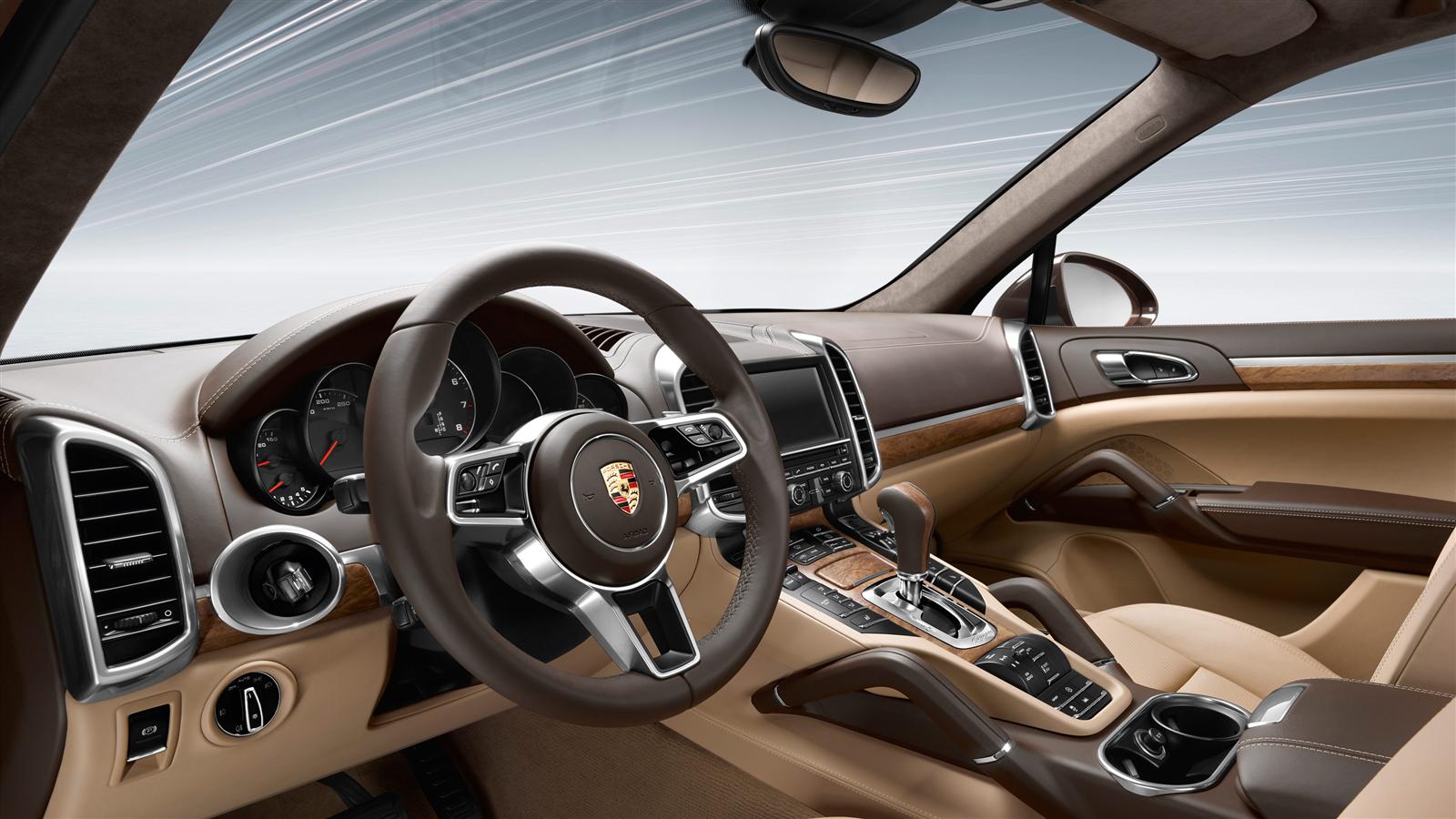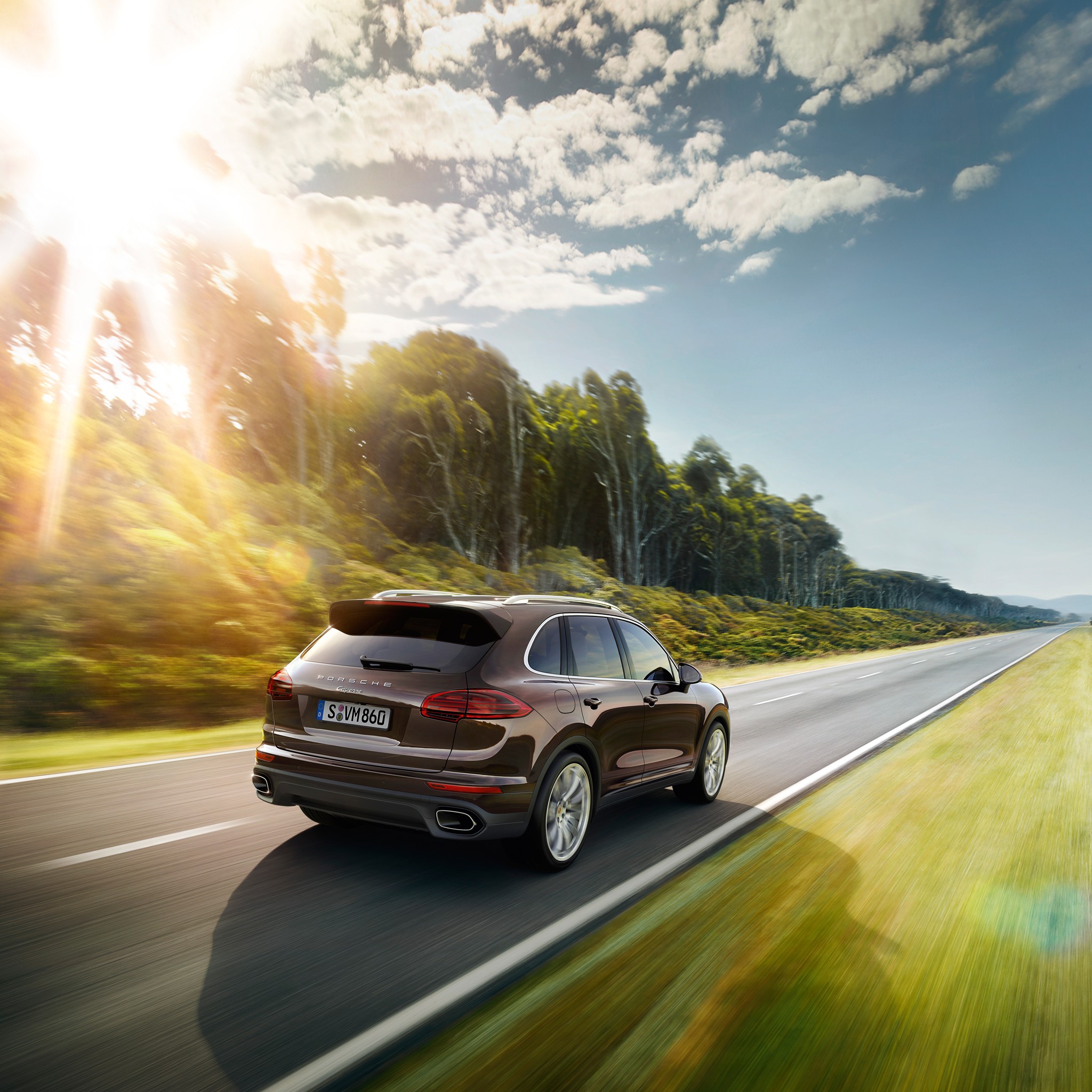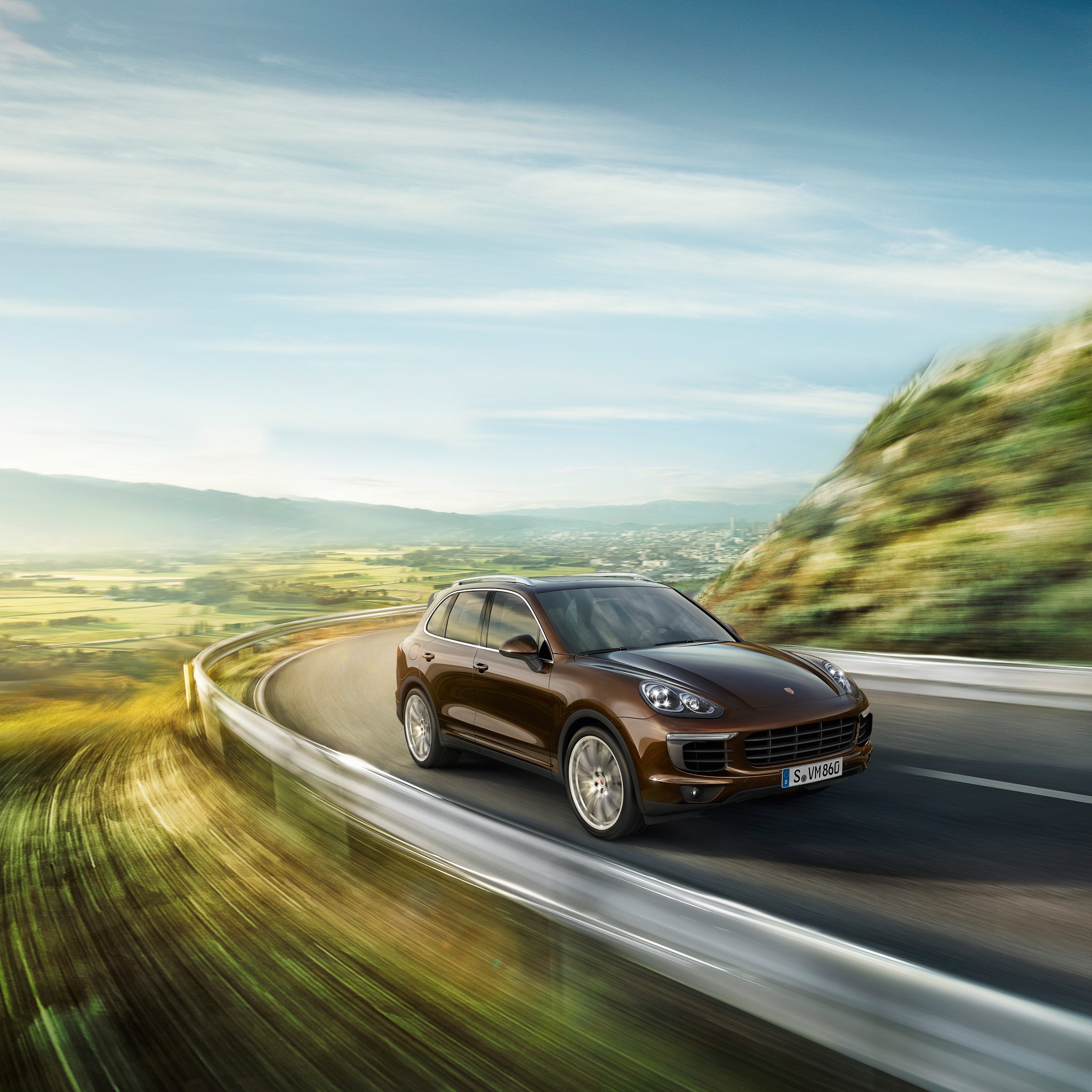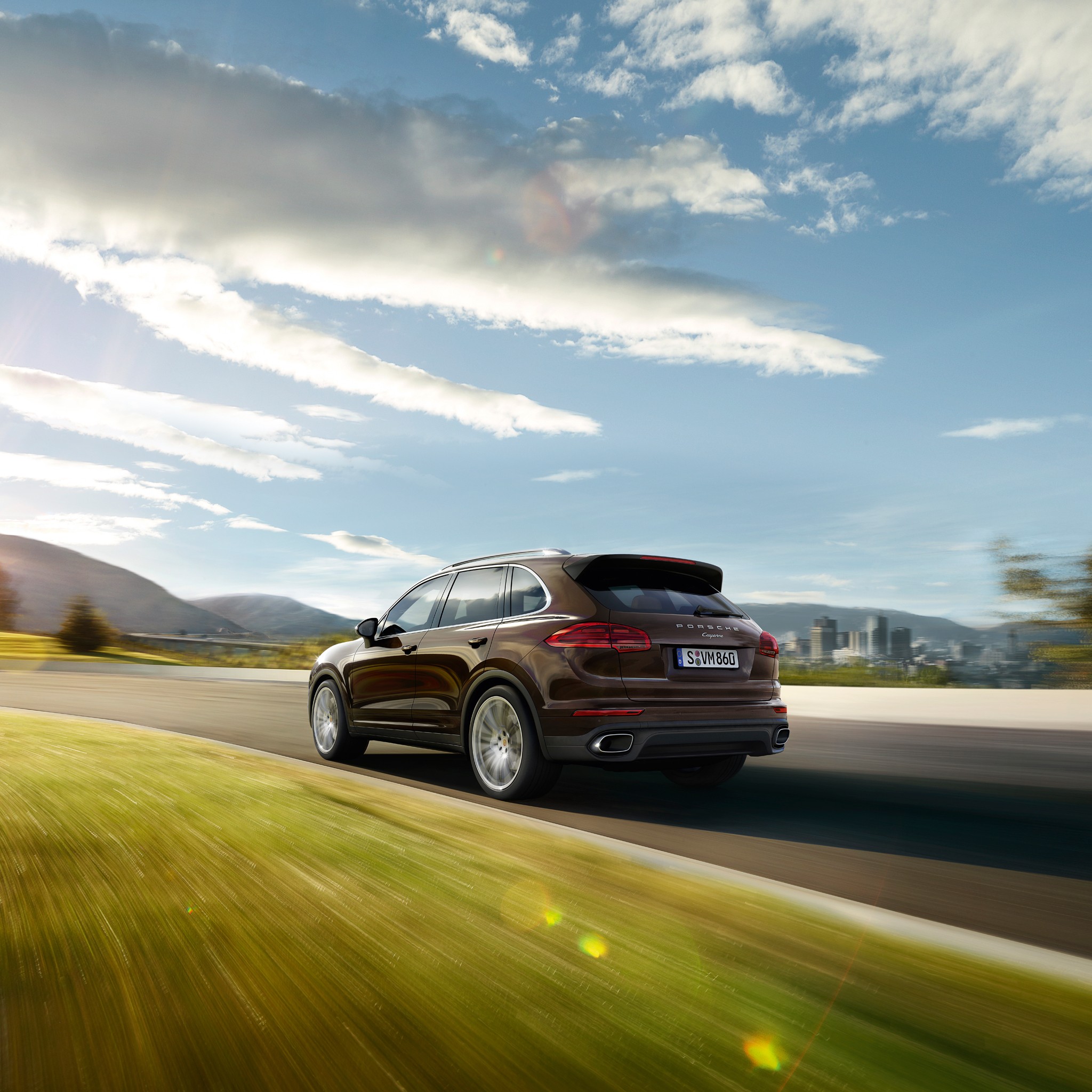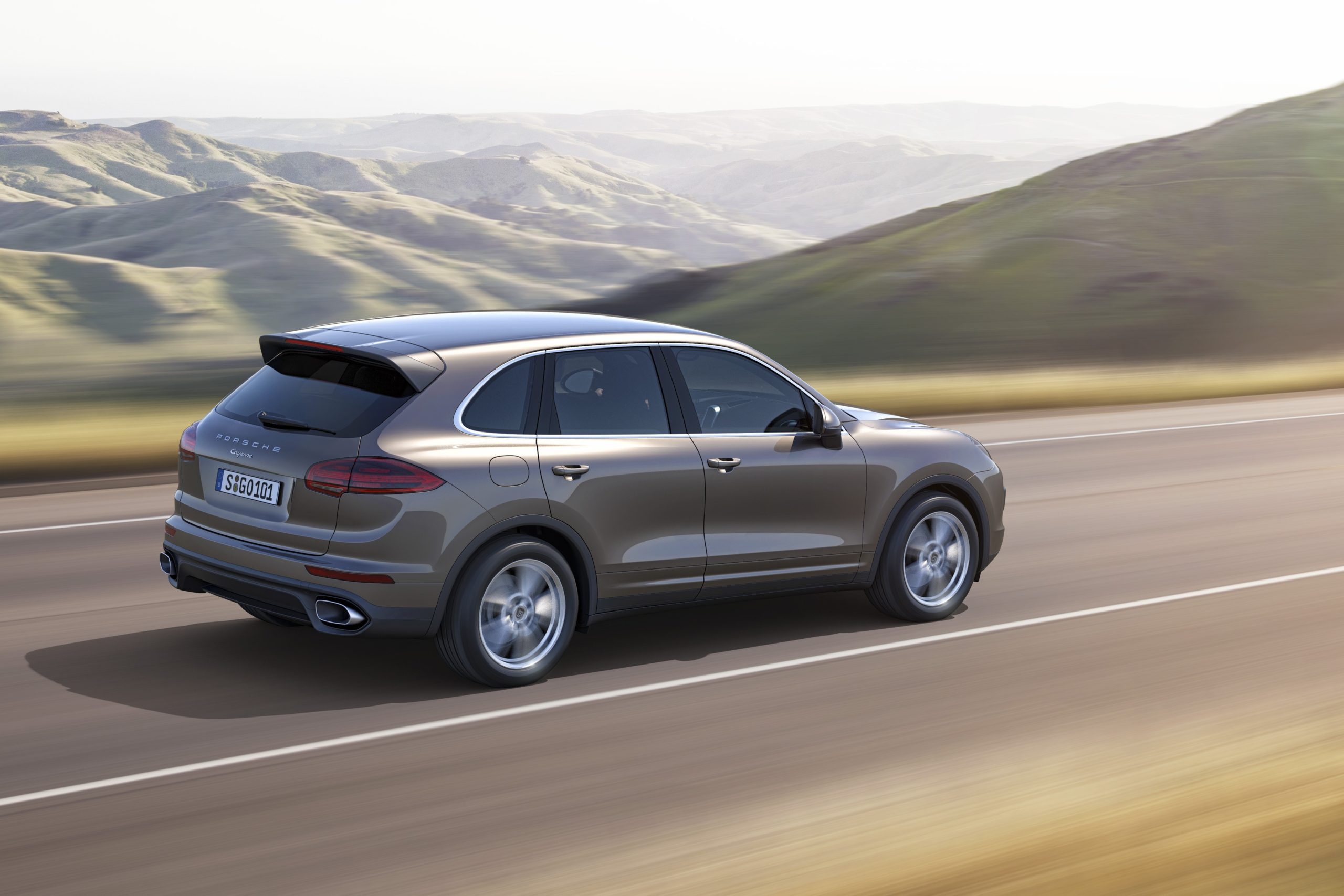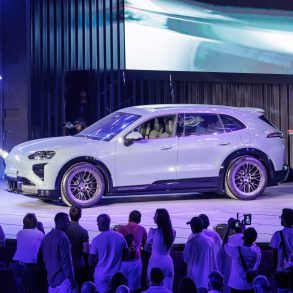(2015 – 2018) Porsche Cayenne – Ultimate Guide
The facelifted version of the Porsche Cayenne was introduced in 2014 and it received a restyled design, new features, and, most important, upgraded engines, starting with the base version.
When it was introduced in 2002, the Cayenne featured a 3.2-liter V8, which was the access model in the new SUV range. It was available with a manual gearbox. For the second generation’s facelift, the Cayenne was a far better option.
The exterior of the 2014 Cayenne was enhanced with a sharper design and clear lines. The front fenders, the grille, and the headlights were entirely new. The grille was still divided into three main areas, with the biggest one kept for the engine. The underbody aluminum shield was replaced by a black plastic one. In the back, the roof-spoiler became a standard fit for the entire range.
Inside, the connection with the 911 range was more obvious due to the five-dials instrument cluster and the centrally-mounted tachometer. The new, tall and slim, air-vents were inspired by the Panamera sedan, but on the center console, the buttons from the PTM system were an updated version of those found in the first generation Cayenne.
Under the hood, the 2014 Cayenne offered a naturally aspirated 3.6-liter engine. The displacement resembled the flat-six engines from the 911 range, but in a mid-size SUV, the V6 was a better choice. It offered 300 hp and it was the only naturally aspirated Cayenne on the market. The manual gearbox was deleted from the standard, and options list.
Pictures
Press Release
The success story of the Cayenne began in 2002 when it expanded the term “spread” to include several further dimensions. The Cayenne made the idea of a sports car in the SUV segment a reality.
Commute to work today and drive off-road or on the racetrack tomorrow – the Cayenne offers ambience, precision and driving pleasure on every terrain. And with five seats and extensive, high-quality equipment and features it has plenty of room for a whole lot of fun behind the wheel. With the typical Porsche design DNA.
Thanks to its balanced overall package the Porsche Cayenne has exceeded all sales expectations. More than 276,000 first generation vehicles rolled off the production line, and more than 303,000 units of the second generation Porsche Cayenne that was introduced in 2010 have already been sold. The Cayenne therefore makes an important contribution to profitable growth for Porsche and at the same time it contributes to ensuring that Porsche has a wide range of highly dynamic vehicles – from sports cars to saloons, SUVs and even motorsport vehicles.
The new Cayenne continues this path. Increased efficiency, even more precise handling, a sharper design and even more extensive standard equipment – these are its defining features. Five models are available right from the start: Cayenne Diesel, Cayenne S Diesel, Cayenne S, Cayenne Turbo, and – as a world premiere – the Cayenne S E-Hybrid, the first plug-in hybrid in the premium SUV segment. It offers outstanding fuel consumption and emission values in the premium SUV segment: 3.4 litres per 100 kilometres and 79 g/km CO2 are figures that speak for themselves, especially considering that it is a vehicle with all-wheel drive. Together with the Panamera S E-Hybrid and the 918 Spyder, Porsche is the only manufacturer worldwide to offer three plug-in hybrid models.
All Cayenne models boast lower fuel consumption and improved performance
Increased performance and torque coupled with lower fuel consumption: this is no contradiction for Porsche. The familiar engines have been upgraded and optimised for the Cayenne. They consume less fuel than their direct predecessors and yet have improved performance figures.
The Cayenne S with a 3.6 litre V6 bi-turbo engine is new. This engine was specially developed for Porsche SUVs and was initially fitted in the Macan. In the Cayenne S it surpasses the previous V8 engine in all key data. The bi-turbo charging and downsizing via a reduction of the engine capacity and the number of cylinders enable a clear efficiency increase coupled with improved driving performance. For example, the power output has increased by 20 hp to 420 hp and the torque has increased by 50 Nm to 550 Nm, whilst the fuel consumption has fallen by 0.9 litres to less than ten litres per 100 kilometres.
The power output of the top model Cayenne Turbo has also increased by 20 hp to 520 hp and the torque by 50 Nm to 750 Nm. It therefore accelerates three tenths of a second more quickly than its predecessor and reaches a top speed of 279 km/h. Nevertheless, fuel consumption has been reduced by 0.3 l/100 km.
Not only the new Cayenne S E-Hybrid but also the diesel models set standards in fuel consumption. The Cayenne Diesel now has more power and torque coupled with a reduction in fuel consumption and therefore an increased maximum range. Thanks to a larger turbocharger, the maximum power output of the three-litre V6 engine has increased by 17 hp to a total of 262 hp, whilst the maximum torque has increased by 30 Nm to 580 Nm. This is manifested in the sprint from 0 to 100 km/h that is now 0.3 seconds faster and a top speed of 221 km/h – with fuel consumption of 6.8 to 6.6 l/100 km.
The Cayenne S Diesel cleverly combines the advantages of a charged diesel engine with the emotional appeal of a petrol engine. The 4.2 litre V8 turbodiesel engine develops a power output of 385 hp and an impressive 850 Nm of torque and thus offers ample power reserves for every situation. It sprints from 0 to 100 km/h in 5.4 seconds. The top speed is 252 km/h. Fuel consumption in accordance with the NEDC is 8.0 l/100 km.
General efficiency measures
Numerous efficiency technologies in the whole drivetrain contribute to reducing the fuel consumption of the new Cayenne, for example an optimised eight-speed Tiptronic S with coasting function, a further developed auto start/stop function Plus, and also an improved thermal management.
The extended auto start/stop function Plus shuts down the engine as soon as a slow walking pace is reached whilst the driver is braking, for example when approaching traffic lights. This function can be deactivated via a button on the centre console if need be. The auto start/stop function is automatically deactivated in Sport and Sport-Plus mode.
For the first time, all Cayennes now have the coasting function familiar from other Porsche model series. The developers have modified the eight-speed Tiptronic S accordingly. When the driver takes his or her foot off the accelerator pedal, Tiptronic S automatically decouples the engaged gear, and the vehicle “coasts”. When the accelerator or the brake pedal is pressed, the right gear is automatically engaged again and the clutch is engaged. What’s more, intelligent algorithms are used to adapt the coasting function to the driving style. It can be switched off via the auto start/stop button.
For the first time active cooling air flaps are fitted behind the central air inlet in the Cayenne, that are controlled by engine management. They open and close depending on the driving situation and the cooling-air requirement. This regulates the air volume, influences the aerodynamics and is part of the thermal management so that the engine and gearbox warm up quickly and reach an optimum working temperature.
The intelligent thermal management in the Cayenne regulates engine and gearbox cooling in order to reduce the loss due to friction during the warm-up phase. The engine and gearbox heat up more quickly thanks to specific control of the heat flow and gradual activation of the different cooling circuits as required. In addition, the new cooling air flaps are linked to the thermal management for quick heating up of the drivetrain units during a cold start. Not only does this have further potential for reducing the fuel consumption, it also enhances comfort as the interior reaches the desired temperature more quickly.
Sport Chrono package: now with Performance-Start
For the sprint from 0 to 100 km/h the optional Sport Chrono package offers Performance-Start for the first time in the Cayenne. The driver activates this function by pressing the brake and the accelerator pedals at the same time and the display in the instrument cluster then shows that the vehicle is ready to start. This action signals to the control units that the driver would like a Performance-Start. The engine speed is increased and Tiptronic S is prepared for this – the important gear changes for the sprint from 0 to 100 km/h from first to second and from second to third gear are optimised. The Sport Chrono package improves the time of all Cayenne models by 0.1 seconds.
Sharper design and clear lines
The Porsche designers have given the Cayenne a sharper and clearer design in its latest guise. At the same time the design emphasises the proximity of the Cayenne to the road and underlines its sports car character.
The rear of the new Cayenne in particular has been clearly modified. The rear lights now have a flatter and more precise design. Like the LED daytime running lights at the front, the brake lights have a four-part design. Registration plate recess, handle strip and lighting are integrated even more elegantly in the tailgate. What’s more, the new tailgate takes up the shape of the rear lights and continues it via a precise horizontal light-refracting edge. This emphasises the width of the vehicle and gives it a more powerful road stance. The new design of the exhaust tailpipes that are integrated in the lower rear panel also contributes to this. All Cayenne S models now also feature a double-pipe design. The roof spoiler no longer has a step which means that it continues the basic line of the roof even more consistently and has a more powerful appearance.
Front: a subtle stronger presence
It is the front of the vehicle that plays a decisive role in shaping the overall look – and this is why the front end, wings and bonnet have also been completely redesigned. For the viewer all main design lines now no longer run towards the middle, but outwards. This gives the Cayenne a much wider and therefore more powerful look.
The bonnet has a much wider design and its side gaps are now on the wings. The central air inlet is now somewhat smaller than that of the predecessor and this underlines the tautness of the front view. It is flanked by two further external air inlets that now appear even more voluminous and have moved outwards. The “airblades” on the right and left sides of the vehicle front efficiently channel cooling air to the intercooler and are also an eye-catching highlight.
The bi-xenon main headlights that come as standard on the basic and S-models with the “floating” four-point LED daytime running lights typical of Porsche clearly identify the new Cayenne as a Porsche at first glance. The premium character of the Cayenne Turbo top model is underlined by LED main headlights as a standard feature including Porsche Dynamic Light System (PDLS).
On the side view of the Cayenne the sporty roof line sloping downwards towards the rear is an attractive feature. The modified design gives the front and rear a more precise and therefore also a more striking look. Further design features are the side mirrors with integrated indicators, the sharper lines of the wings and the clearer presence of the roof spoiler. This also improves aerodynamics by minimising air turbulence.
New colours
New exterior and interior colours are available for all models. Highlights include the exterior colours carrara white metallic and palladium metallic that are available for all models. All models can be ordered with an interior in the two-colour colour combination black/luxor beige at no extra charge. Dark walnut-burr trim is a new optional feature available for the interior.
Enhanced comfort and driving dynamics
The Porsche Cayenne has many strengths and its suspension is one of them. In the new Cayenne the developers have increased the spread between comfort and sportiness even further – in every variant: with steel suspension, Porsche Active Suspension Management or air suspension.
The engineers paid great attention to the details. Their extensive package of measures for all Cayenne models includes optimised suspension points that greatly contribute to enhancing comfort together with a new suspension configuration. For a more precise response there are new multi-part mounts on the transverse links of the front and rear axle and on the wheel mounts of the rear axle. The wheel suspension is now much more exact. The Cayenne’s suspension is even more precise, sporty and at the same time more comfortable.
In the Cayenne the Porsche Active Suspension Management (PASM) is coordinated for interaction with the new Sport Chrono package and its extended functions, and for when the Sport Plus button is pressed. The three familiar PASM suspension programmes are now called Comfort, Sport and Sport Plus. The Cayenne S E-Hybrid comes with PASM as a standard feature, whilst the Cayenne Turbo additionally boasts air suspension.
The air suspension that is available as an option for all other models meets the Cayenne’s high demands on premium comfort, outstanding driving dynamics and suitability for both off-road and everyday use. The level control system included with the air suspension offers a total of six different vehicle heights depending on the driving situation. The lowerable load sill is a new feature of the Cayenne: pressing a button in the luggage compartment lowers the loading level by 52 millimetres when the tailgate is open. The height of the load sill is then approximately 69 centimetres.
New aluminium wheels with a multi-spoke design in 18- to 21-inch format are now available for the Cayenne. They are all lightweight with an attractive and independent design. Highlights include the new 21-inch wheels in a 911 Turbo design and Cayenne Sport Classic design. Furthermore, a new generation of 21 inch summer tyres will be introduced – including the recently launched MICHELIN Latitude Sport 3. These tyres have been developed particularly for performance and sporty driving and due to the special rubber compound and the low tyre aspect ratio they offer the driver significant advantages, especially when cornering at high speed. To achieve this, the three basic components of the tyre have been modified: the rubber compound, the tread pattern and the casing design.
Even more comfortable and safe
The new Cayenne generation now comes with even more standard equipment. This includes bi-xenon headlights for all models. Befitting its rank, the Cayenne Turbo comes with LED main headlights as standard including Porsche Dynamic Light System (PDLS).
Further standard equipment of all models includes an automatic tailgate, a multifunction sports steering wheel including shift paddles, stainless steel door sills, a tyre pressure monitoring system and an audio interface.
The new multifunction sports steering wheel with shift paddles is based on the design of the steering wheel found in the 918 Spyder. A further highlight is the rear bench that is now even more comfortable. What’s more, as with the front seats, seat ventilation is now available as an option for the rear bench.
On request customers can further enhance comfort, for example with a “soft close” function for the doors. This closing mechanism integrated in the doors has big advantages, for example in tight parking spaces. The heated windscreen (available as an option) promises extra comfort in winter. An extremely thin heater foil is used instead of heating filaments. This means that all camera-based assistance systems can be used without any restrictions. A welcome side effect is that the foil integrated in the windscreen additionally reduces the noise level in the interior.
The air suspension facilitates a convenient additional function: pressing a button on the side of the luggage compartment now enables the vehicle and thus the loading sill, too, to be lowered by 52 millimetres from the luggage compartment as well when the tailgate is open. What’s more, the assembly and removal of the luggage compartment cover has been simplified.
Connectivity and assistance systems
All Cayennes come with an interface for the connection of external audio sources. Porsche Car Connect offering simple and quick access to all kinds of different vehicle information and control of various functions via the Porsche Car Connect smartphone app is available as an option for the new Cayenne for the first time and a standard feature in the Cayenne S E-Hybrid.
The range of assistance systems has been expanded and existing systems have been given additional functions. A new feature available as an option from the end of 2014 is Park Assist at the front and rear with Surround View. It enables safe and comfortable manoeuvring, even in parking and manoeuvring situations with poor visibility. To this end three further high-resolution cameras are fitted at the front of the vehicle and in the side mirrors in addition to the reversing camera. The system calculates a virtual bird’s eye perspective of the vehicle from the pictures of all four cameras and shows it on the display of the Porsche Communication Management (PCM).
Adaptive Cruise Control including Porsche Active Safe (PAS)
Adaptive Cruise Control enhances comfort, especially on motorways. The system regulates the speed depending on the distance to the vehicle ahead. Within the range of between 30 and 210 km/h a speed can be set. If the distance to the vehicle ahead is reduced, the system gently brakes the vehicle – if necessary, to a standstill.
If the driver then operates the control lever or the accelerator within three seconds, the system is automatically reactivated and accelerates the vehicle to the previously set speed as a maximum, depending on the traffic situation. The integrated Porsche Active Safe (PAS) provides for even more safety, even when Adaptive Cruise Control is switched off. When approaching a vehicle ahead too fast, it gives an acoustic and a visual signal as well as a brake jolt to indicate the need for intervention. If the driver then reacts, the braking initiated by the driver is intensified within the limits of the system all the way to full braking. A lane change assistant and lane departure warning are also available. The lane change assistant monitors the area to the sides behind the vehicle and also the blind spot, and alerts the driver with a signal in the door mirror when it detects another vehicle in the next lane. The lane departure warning system uses a camera to detect lane markings and warns the driver with a signal tone if the vehicle inadvertently leaves the lane.
The conventional cruise control, a standard feature, now activates the brakes for the first time in order to keep a constant speed – for example on downhill stretches – if releasing the accelerator is not sufficient. A post-collision braking system is also part of the standard specification. It automatically brakes the vehicle involved in an accident after the first collision to reduce the consequences of a second impact. If the airbag sensors signal a collision, the system automatically initiates deceleration of maximum 0.6 g. The assistance system applies the brakes until a remaining vehicle speed of ten km/h is reached. This remaining speed is generally sufficient to guide the vehicle to a safe stopping place following full braking. The driver can override the post-collision braking system at any time: the post-collision braking system is deactivated when the driver presses the accelerator pedal. The automatic system is also deactivated if the driver initiates full braking at an even higher rate of deceleration.
LEDs at the front and rear
The completely new LED main headlights including Porsche Dynamic Light System Plus (PDLS Plus) combine state-of-the-art lighting technology with intelligent additional functions. In addition to the static and dynamic cornering light of the PDLS (standard for the Cayenne Turbo), PDLS Plus additionally includes dynamic main beam: this is put on and dipped depending on the traffic situation. Furthermore, PDLS Plus has an intersection light that recognises the intersecting roads and T-junctions stored in the navigation system of the PCM, and illuminates the area to the left and the right with simultaneous activation of the static intersection light. What’s more, LED headlights are much more energy efficient and their daylight-like light colour resulting in increased perception of contrasts can prevent driver tiredness.
The indicators are now integrated in the side mirrors instead of in the front wings.
The new LED rear lights clearly distinguish the Cayenne from the predecessor generation. They have a flatter and more precise design. Fibre-optic cabling gives the lights a more delicate and homogeneous appearance. What’s more, the rear lights also feature a four-point design for the brake light, like the new four-point daytime running lights in the main headlights. The rear fog lamp is now integrated in the reflectors in the lower rear panel.
The first plug-in hybrid in its segment
The Cayenne S E-Hybrid is a true world first, even outside the Porsche model range: it is the first plug-in hybrid in the premium SUV segment and it sets standards among luxury all-wheel-drive vehicles. Its high-voltage battery enables it to be charged both at a mains supply and during the journey.
Distinctive features of the Cayenne S E-Hybrid are the brake callipers in acid green and appropriate emblems. The needles of the cockpit instruments also feature this distinctive colour.
Very clear technical advances have been made compared with the previous Cayenne S Hybrid: the Cayenne S E-Hybrid has a lithium-ion drive battery that now has energy content of 10.8 kWh (previously: 1.7 kWh, from a nickel-metal-hydride battery), which enables pure electric driving for 18 to 36 kilometres, depending on the driving style and the topography. This enables most everyday journeys to be made without consuming any fuel or producing any local emissions. The power output of the electric motor has more than doubled – from 34 kW to 70 kW (95 hp). The overall fuel consumption is now 3.4 l/100 km instead of the previous 8.2 l/100 km, corresponding to CO2 emissions of 79 g/km. The old model emitted 193 g/km.
The drivetrain has already proved itself in the Panamera S E-Hybrid, and has been adapted for use in the Cayenne S E-Hybrid. As with the former, the power development of the electric motor and the activation of the combustion engine can be precisely regulated via the accelerator that has an activable pressure point. At 416 hp, the combined total power output of the charged three-litre V6 engine and the electric motor coupled with total torque of 590 Nm enables performance at sports car level: 0 to 100 km/h in 5.9 seconds and a top speed of 243 km/h. The electric top speed is 125 km/h. The Cayenne S E-Hybrid is networked via Porsche Car Connect (a standard feature). Information, for example on the state of charge or energy efficiency, can be accessed or the optional stationary heating/air conditioning can be controlled. This cools and heats the vehicle interior when the ignition is switched off – in order to reach the desired temperature before setting off whilst the vehicle is still connected to the electricity supply. The energy needed on the road is reduced and the electric range is increased.
Details of a perfect plug-in-hybrid concept
The lithium-ion battery has the same housing as in the Panamera S E-Hybrid and it is also accommodated under the load compartment floor. But it has cells with a greater capacity – 28 Ah instead of 24.5 Ah.
The vehicle comes with a 3.6 kW charger as standard. An integrated charger with power output of 7.2 kW is available as an option and charges the Cayenne S E-Hybrid twice as quickly as with the standard charger – assuming that an appropriate electrical connection is available. For example, in Germany the vehicle is charged in less than an hour and a half instead of just under three hours.
The pressurised fuel tank is a special feature of the Cayenne S E-Hybrid. Slight positive pressure of 0.3 bar in the tank ensures that degasing fuel does not escape outside to worsen the emission balance. During refuelling the tank is depressurised by pressing the fuel flap release button and the fuel gas is neutralised via an activated carbon filter. Needless to say, the Cayenne S E-Hybrid complies with the Euro 6 emissions standard.
High level of hybrid expertise at Porsche
Porsche is the leading supplier of premium hybrids. As the first plug-in vehicle in the luxury class, the Panamera S E-Hybrid set standards when it was launched in June 2013. The Cayenne S E-Hybrid now carries this forward-looking technology to the premium SUV segment. With its record-breaking time on the Nürburgring in September 2013 the 918 Spyder demonstrated in impressive style that even super sports cars can achieve new dimensions in performance and clearly leave conventional drive systems behind when it comes to driving dynamics and efficiency.
In this respect, the 919 Hybrid – the LMP1 class Porsche race car for competing in the World Endurance Championship (WEC) -has a pioneering role as a high-technology vehicle . It is a research laboratory on wheels for the further development of hybrid technology with the aim of achieving maximum dynamics and efficiency. Its drive combines a charged V4 petrol engine that drives the rear axle with two energy recuperation systems. In addition to braking energy recuperation a generator operated by the exhaust-gas flow generates further electric power. This is stored in a water-cooled lithium-ion battery and released to an electric motor which drives both front wheels via a differential when the vehicle accelerates. This means that the 919 Hybrid has all-wheel drive at times. The coordination of all drive components is extremely complex and has the aim of making every second on the racetrack completely predictable whilst driving with maximum precision and speed. Independent of race results, Porsche gathers knowledge and experience with every kilometre that the 919 races, and this will help give future generations of sports cars a competitive edge.
Incidentally, the world’s first hybrid vehicle also came from Porsche: the 1899 Lohner-Porsche designed by Ferdinand Porsche combined battery-electric drive with a combustion engine.



